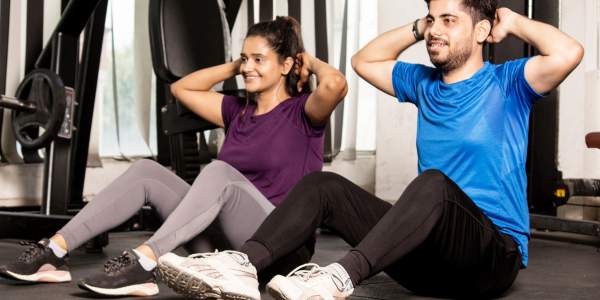For many, the changes that 2021 brought to daily life have also abruptly halted their workout routine. But now, as many people work to establish their new normal, routines are being set into motion. Whether you are ready to be back on the gym floor, join a fitness class, or set up a new home studio, experts say it’s best to ease back into your workout rather than go full force.
Your body is probably not the same.
When you forgo your workouts for a few months or are not as consistent, you can expect a few changes in your body.
You may notice you don’t feel as strong, and you may even get winded sooner. This is due to decreases in muscle mass, blood flow, and oxygen.
The good news is that it doesn’t mean your once-conditioned body is gone forever. You can get there again, and if you do it wisely, you can avoid injury or burnout.
Start slow and steady
It’s probably true that the first workout will be the hardest, but your muscle memory will kick in and get you through. Start by scheduling 20-minute sessions, two or three times per week, and then increasing the length and number of sessions as the weeks progress. And don’t forget to drink water! Your muscles will need to soak up that extra hydration.
Choose your workout wisely
Flexibility
Flexibility is a great place to start because it’s a perfect way to get your body ready for the demands of a new workout routine. You can gently increase your blood flow and circulation while stretching your body into a broader range of motion and joint mobility. Try these light stretching and yoga poses found right on our SMART MAT products.
SMART MAT ROUTINE
- Seated Supine Twist
- Butterfly
- Hip Bridge
Cardio
After a couple of stretching or yoga sessions, try to incorporate some light cardiorespiratory workouts. Depending on your fitness level prior to your break, your definition of light work may look slightly different from your fellow fitness enthusiast. Try some light cycling, hiking, or lower-impact HIIT training to start.
Low-Impact HIIT
Usually, when we think of HIIT training, it can involve a lot of jumping and full range movement throughout all three motion planes. As you ease back into your fitness routine, skip or modify the plyometrics for now, and keep the range of motion smaller as your body adjusts.
Equipment needed: SMART MEDICINE BALL
HIIT WORKOUT:
Try this routine:
- Jump to Wide Squat with Hold, Walk Legs Back In.
- SMART Med Ball Walking Burpee
- Duck walk with a backward shuffle
- Side Knee Repeater
30 seconds each. 4 rounds. Repeat! ((Be sure to switch up those legs for the knee repeaters each round.))

Strength
If your time away from your fitness routine involved a lot of sitting, your posterior chain muscles are probably weaker than when you were working out consistently. When getting back to strength training, your first priority should be to improve your posture, develop core strength, and start to activate your hamstring and glute muscles.
Squats and lunges with light or even just bodyweight are great exercises to start with to build up those legs. SMART STRAPS can be a perfect transition tool for getting back to a strength routine and can make for an amazing full-body workout. And, get comfortable with the SMART Stability Ball routine because this may be your most versatile ticket to regaining your core.
SMART STABILITY BALL CORE WORKOUT:
If you need a routine to get you started, try this one. Then, mix it up by following the rest of the exercises printed right on the product.
Stability Ball Supine Leg Twists: While laying on your back, place the ball between your legs at calf level, holding upright. With arms at your sides on the floor, move your right leg toward the left side of your body and your left leg toward the right side of your body while keeping the ball still between your legs. Now do the opposite direction. Repeat.
Stability Ball Hamstring Roll-Ins: Keeping your hips up, push your heels into the ball, and drag your ball back toward your body. Squeeze your backside and hamstrings, and slowly extend.
Stability Ball Stir Up: Push your forearms into the ball. Move the ball in a circular motion while keeping your body still and aligned while in plank position.
Take the time to recover
Even if you were never one to stretch post-exercise, it’s time to put that in your routine now. Take advantage of your warmed body by following a stretching routine, and you’ll avoid muscle tightening and spasms. Foam rolling with our SMART Recovery Foam Roller is also an excellent recovery tool for post-workout. A session can help you restore blood flow to the muscles and help relax the fascia, which leads to a faster recovery.







